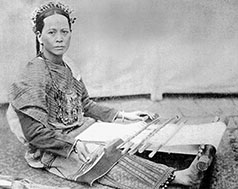
服飾與織品
Clothes and Textiles

噶瑪蘭織布工藝
The Kavalan Weaving Craft
過去噶瑪蘭婦女能夠使用水平背帶織布機,織出漂亮的織布,製作不同型式的衣服。早期清代方志記錄中經常提到宜蘭噶瑪蘭人精湛的織布工藝,除了臺灣原住民普遍製作的苧麻和棉毛夾織布之外,噶瑪蘭人還擁有傑出而特殊的香蕉絲織布技術。
18世紀末期起,漢人移墾勢力侵入宜蘭平原,噶瑪蘭人的土地和傳統生活方式快速受到影響而流失。至19世紀晚期,大部分噶瑪蘭人已改穿著漢式棉布衣,織布工藝技術也因而難以維持而逐漸磨滅。從1890年代馬偕採集的宜蘭噶瑪蘭相關織布文物和婦女織布照片,我們可以推想噶瑪蘭織布傳統維持至19世紀末期的景況。另外,美國紐約自然史博物館保存的淺井惠倫1930年代在花蓮加里宛社採集的織布資料,則反映出噶瑪蘭人19世紀中葉起陸續遷移至花蓮之後,織布工具和織紋的變化。
Kavalan women popularly used the horizontal back-strap loom to weave beautiful textiles and to produce clothes. In the historical documents of the Qing dynasty, many records mentioned that the Kavalan people in the Yi-lan Plain had extraordinary weaving skills. They wove beautiful textiles not only from ramie and wool threads like other indigenous groups, but also wove special banana fiber textiles.
Following the invasion of the Han Chinese settlers in the Yi-lan Plain in the late 18th century, the Kavalan people lost their lands and traditional way of living under strong pressures. Many Kavalan people changed their clothing to Chinese cotton costumes by the late 19th century. Thus, the traditional weaving crafts have been gradually forgotten and lost. From the collected weaving materials and the photo illustrating a weaving woman (published by Rev. G. L. Mackay in the 19th century), we can imagine the traditional way of Kavalan weaving in the Yi-lan Plain. Furthermore, from the Kavalan weaving materials collected by Prof. Erin Asaii in the Hua-lien Kalewan village and preserved in the American Museum of Natural History, we can see the changes of the Kavalan loom and weaving patterns in the early 20th century after migration to Hua-lien.
 平埔族織布婦女 (馬偕1896) A Peopo weaver (Mackay 1896) |
 噶瑪蘭新娘盛裝復原圖 (胡家瑜2015) An illustration of the Kavalan bride in ritual dressing (Chia-yu Hu 2015) |
|---|
